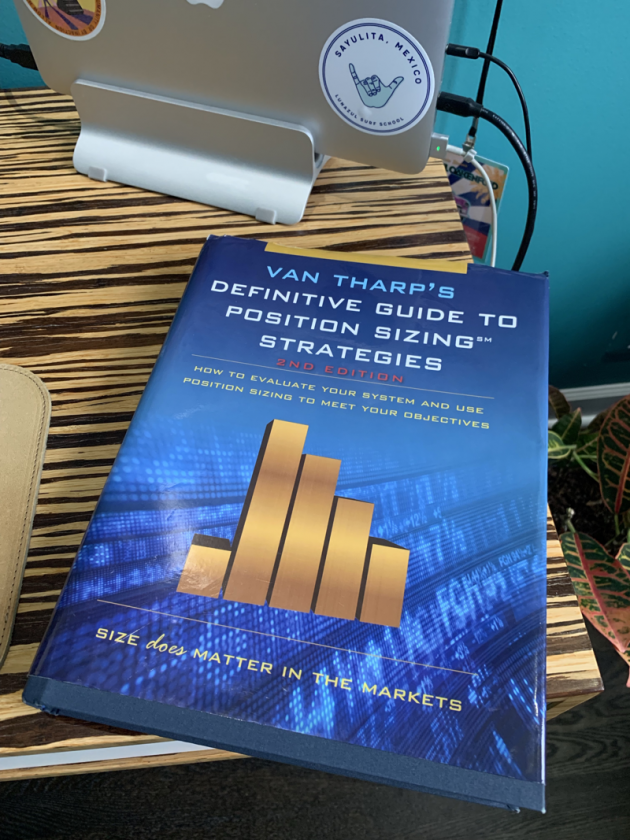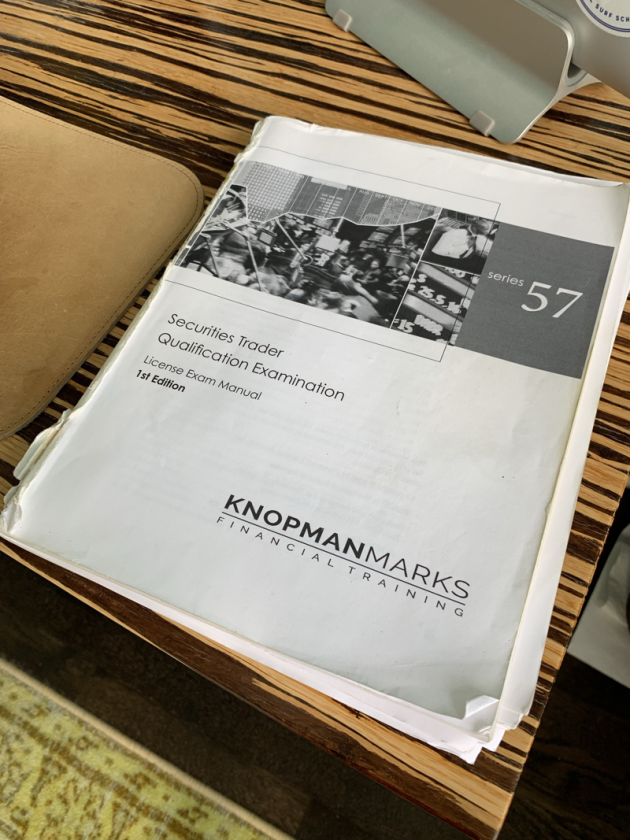You Don’t Know What You Don’t Know
You Don’t Know What You Don’t Know
I’m back… back again while Mole is unplugging in France.
Picking up where I left off on my last post, I want to address a couple of things my trader cronies e-mailed me about after reading last weeks post about my workshop experience at Van Tharp.
With everything I’ve experienced, I still feel Van Tharp is the best trading educator out there for the inner work of trading. Especially for people who are not genetically predisposed to play the game at kill-crush-conquer levels. At the inner game of trading, they do an excellent job of this. I’ve sent aspiring trader friends there for a trader chakra balance via the 101 course before sending them off to Learn Python The Hard Way.
Van Thap does have some other things that I feel are extremely beneficial. The Trade Your Way To Financial Freedom book is an excellent primer and is mandatory reading for any new trader, the $35 Amazon copy is adequate. If it was $500 it would still be worth it.
If you have some systems that are consistently generating positive expectancy, I’d strap a turbo on them and drop $250 for the Van Tharp Position Sizing book here:
https://www.vantharp.com/definitive-guide-to-position-sizing-strategies
It’s a huge book and very well researched, it is the bible for non-quant position sizing. There are lots of nuggets of gold hidden within it and many in plain site. Warning: the advanced concepts in this book will, with ruthless efficiency, lay waste to any trading account where they are not applied to sound trading systems.
As for my class experience there, if the class I took there was “Concepts For Building Trading Systems”, I’d have known exactly what I was getting into and be extremely satisfied. However that’s not what I signed up for. Ken Long’s courses have some very useful ideas in them, such as the Frogbox concept and using Z-scores for various metrics.
His application of using statistics for trading is novel and unique, and you can tell he has put a metric ton of time into them. But the course is marketed as proven trading systems and as taught in the class, they are not prime time ready with a positive expectancy anywhere near advertised.
In retrospect, would I spend the time and money to go through the agony again? At the risk of sounding bat shit crazy: Yes. I think you need to have a few screws loose to want to play the trading game hard. However I’m a 5 standard deviation outlier (so is Mole) and I’ll dive into the why in my next post.
Circling back to prop trading, if you’re sitting at home by yourself trading without a peer network of other traders who are CRUSHING it, you are at a huge disadvantage. You don’t know what you don’t know. And knowing can change the game. Similar to what Tony Robbin’s says, your trading results are heavily influenced by the traders you associate with. Are you associating with other traders who are CRUSHING IT or clueless chat room amateurs? In the past letting amateurs influence my trading has been deadly to my account.
On to some of the benefits of prop trading, I spoke a bit about the 20:1 leverage, which is quite useful in two main ways.
First, high leverage allows us to trade things like one of my fav momentum targets VNQ, which is essentially untradable at the retail level. With a retail account with 4:1 intraday leverage, VNQ is essentially untradable because it’s low volatility and it’s currently in the low end of low volatility. It requires relatively huge position sizes.
In my momentum intraday algos, I use a base 1R = .8% of account value and with these settings, I needed almost 6:1 leverage to put a trade on in VNQ last Wednesday. And I still had plenty of dry powder for other trades. With a retail account, you probably could squeeze out a position around 1R = .5%, but then your entire account would be tied up in one position, which is not feasible.
If your are what is referred to the prop world as an Aim And Shooter (i.e. chart trader), you might die of boredom watching one position drift along all day to 3.2R of glory.
The second advantage of leverage is that when the market is raging, we have enough wind power to put the entire fleet out to sea. One of my best trading days this year was Friday 1/4/19 with a net 13.4R. On this day, the market was raging higher, I had many positions on in my momentum algos and not shockingly, as I’ll expand on shortly, was short several of the volatility ETFs.
Note: this was not a typical day for me, 10R+ days happen once a month, twice if I’m lucky. My portfolio wide stop loss is -3R for a day which also happens about once every few months.
Why I remember this day well is I was surfing all day with my good friend Satish near Punta Del Mita in Mexico and caught the recap on my trades when we returned to our AirBnB that evening.
All in, the battery of algos had 7 positions on concurrently at one point in the session. That would never have happened in a retail account because I would have hit 4:1 with only 2-3 positions. Considering what I’m about to share with you about the volatility ETFs and retail accounts, best case I would have only netted 3-5R that day if I had been trading the same algos at the retail level.
Another benefit of prop trading is the ability to short the the volatility ETFs intraday, or stocks that everybody is shorting and are impossible to borrow. VXXB, UVXY, TVIX and VIXY are regulars in my shorting regimine. However most of these have reduced leverage restrictions and/or are difficult to borrow and at the retail level. Check out IB’s restrictions on them! I will speak at length about these in my next post.
Because of the leverage restrictions (many are 2:1 instead of 4:1 post ETF blow up), they are difficult to near impossible to day trade in retail accounts. None of these precursors exist at the professional level.
And then of course there are rebates. If you’re not familiar with rebates, as professionals, we get paid-to-trade. We pay commissions, just like at the retail level, but we get full exchange rebates for providing liquidity to the exchanges. Typically, rebates are 1.5x commissions round trip, depending on the specific deal you have with a firm.
So if commissions are -$2/1k shares, rebates are +$3/1k shares, resulting in a net +$1/1k shares or so. This changes the game on what type of strategies a trader can run, such as hedged strategies that slightly break even on a R basis but net dump truck loads of rebates into a traders monthly statement. It’s also lovely to see things credited into your account at the end of the month rather than debited.
One of the biggest benefits of trading with a prop firm? You’re among other REAL traders that make a REAL living with REAL trading. They feed their families by trading. The firm I’m with has offices in NYC and Chicago with about 150 traders total, that’s quite a mastermind of real traders.
Everytime I swing by the office and hang out for a bit, I learn something useful. On a visit to the office back in November, I got a thorough schooling from a VWAP trader on how VWAP algos work with intraday metrics. By work, I mean when large fund traders are given marching orders to buy/sell huge positions, how they use them and on which time frames are highly significant. After follow up R&D on my own, integrating these concepts into my momentum and mean reversion algos juiced the expectancy a bit.
On another visit that was to discuss python API stuff, I got a crash course from a partner in using the hard-to-borrow list with the aforemetioned volatility ETFs in the proper context.
Having a trade desk that has your back and pro support people is a huge plus. Once when I was in Mexico, an API update caused an algo to crash near the close and left me with open positions. I got a text, was without computer access and they helped me safely bring the ships back into the harbor.
There is also access to software engineers that know trading, graduate and PhD interns in both software and finance from the University of Chicago for R&D projects. The support bench is deep with A-players. Everyone is IN IT TO WIN IT.
And of course tax benefits. Most prop firms are structured as partnerships. Which in practical terms, means at the end of the year your trading P&L is reported via a K1 instead of a 1099. The benefit? If trading is your primary income vehicle, you’re not subject to the 15% self employment tax that you would be with 1099 short term capital gains.
What are the downsides to prop trading? The biggest one is the firm takes a cut of your trading profits. Depending on your deal, this can be anywhere from 50% (if you’re trading a house account) to 5% – 10% on your own account. You also have to disclose your outside trading accounts to make sure you’re doing not shady stuff like hitting the other sides of your trades. The outside disclosure is handled by most brokers, once you set it up, it’s automated. All in, it’s a small price to pay for the benefits.
Quant Jesus Dr. Ernie MF’n Chan mentions in one of his books that your strategies can get piggy backed by a firm, but I’ve never heard of that happening since it was a thing 10 years ago. If you’re crushing it, a good firm will give you the firms capital to trade in addition to your own.
You also have to pass the Series 57 exam, which kind of sucks. It’s a solid 30-40 hours of studying. However there are gems of wisdom in the study book for any day trader, like the rules on when market makers are allowed to dramatically widen the spreads, or times in the session when big caps like AAPL can execute big buy back programs. I’ll pluck out some of the gems from the study book in another post.
I’ll bookmark things here and wrap it for today, I need to hustle out the door to Orange Theory. In my next post, I’ll talk about my journey out of the retail abyss into the professional world.


















